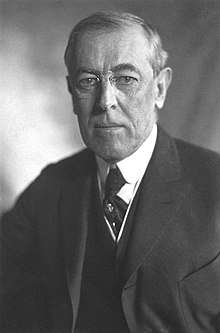Thomas Watt Gregory
Thomas Watt Gregory (November 6, 1861 – February 26, 1933) was an American politician and lawyer. He was a political progressive[1] and attorney who served as United States Attorney General from 1914 to 1919, during President Woodrow Wilson's administration.
Thomas Watt Gregory | |
|---|---|
 | |
| 49th United States Attorney General | |
| In office August 29, 1914 – March 4, 1919 | |
| President | Woodrow Wilson |
| Preceded by | James C. McReynolds |
| Succeeded by | Mitchell Palmer |
| Personal details | |
| Born | Thomas Watt Gregory November 6, 1861 Crawfordsville, Mississippi, U.S. |
| Died | February 26, 1933 (aged 71) New York City, New York, U.S. |
| Political party | Democratic |
| Education | Rhodes College (BA) University of Virginia, Charlottesville University of Texas, Austin (LLB) |
Early life
Gregory was born in Crawfordsville, Mississippi. He graduated from the Webb School (Bell Buckle, Tennessee) in 1881, Southwestern Presbyterian University in 1883, and he was a special student at the University of Virginia. Gregory entered the University of Texas at Austin in 1884 and graduated a year later with a degree in law.
He began the practice of law in Austin, in 1885. He served as a regent of the University of Texas for eight years. Gregory Gymnasium was named in honor of his efforts to provide an adequate exercise facility for the students and faculty of the University. He declined appointment as assistant attorney general of Texas in 1892 and an appointment to the state bench in 1896 but "gained experience as a trust prosecutor as a special counsel for the state of Texas."[2]
While embracing the progressive rhetoric of the early 20th century with his condemnations of "plutocratic power," "predatory wealth," and "the greed of the party spoilsmen," Gregory participated in Edward M. House's Democratic coalition.
Gregory was a delegate to the Democratic National Convention at St. Louis and at state delegate at-large at the Baltimore convention. He was appointed Special Assistant to the US Attorney General in 1913, in the investigation and proceedings against the New York, New Haven and Hartford Railroad Company.
Attorney General
.tif.jpg)
In 1914, President Woodrow Wilson appointed him Attorney General of the United States, and he held that office until 1919. Despite a continuing commitment to progressive reform, Gregory's performance as attorney general provoked enormous controversy because of his collaboration with Postmaster General Albert S. Burleson and others in orchestrating a campaign to crush domestic dissent during World War I.
Gregory helped frame the Espionage and Sedition Acts, which compromised the constitutional guarantees of freedom of speech and press, and he lobbied for their passage. He encouraged extralegal surveillance by the American Protective League and directed the federal prosecutions of more than 2,000 opponents of the war: "By 1918 the Attorney General was able to declare, 'It is safe to say that never in its history has this country been so thoroughly policed.'"[3]
In 1916, Wilson wanted to appoint Gregory to the US Supreme Court, but the attorney general declined the offer because of his impaired hearing, his eagerness to participate in Wilson's re-election campaign, and his belief that he lacked the necessary temperament to be a judge. Gregory was a member of Wilson's Second Industrial Conference in 1919 and 1920.
During a trip to New York to confer with Franklin Roosevelt, Gregory contracted pneumonia and died. He is buried in Austin.
His portrait was painted in 1917 by the Swiss-born American artist Adolfo Müller-Ury (1862–1947); it hangs in the Department of Justice in Washington, DC.
References
- Silberstein-Loeb, Jonathan (February 24, 2014). The International Distribution of News: The Associated Press, Press Association, and Reuters, 1848–1947. ISBN 9781107729391.
- "The new Attorney General". The Independent. August 31, 1914. Retrieved July 24, 2012.
- Peterson, H. C.; Fite, Gilbert C. (1957). Opponents of War, 1917-1918. Madison, WI: University of Wisconsin Press. p. 20.
External links
| Legal offices | ||
|---|---|---|
| Preceded by James C. McReynolds |
U.S. Attorney General Served under: Woodrow Wilson 1914–1919 |
Succeeded by A. Mitchell Palmer |

